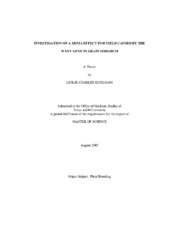| dc.description.abstract | Sorghum grain with a waxy endosperm is more digestible and has a higher
feeding efficiency compared to sorghum grain with a non-waxy (or normal) endosperm.
However, waxy sorghums (Sorghum bicolor (L.) Moench) yield 10-15% less than
normal sorghum and the cause of the yield reduction is unclear. The objective of this
research is to determine if the yield decrease could be due to the waxy phenotype itself.
The waxy phenotype is an example of a xenia effect, where the pollen not only
contributes to the genotype of the resulting hybrid, but also immediately influences the
phenotype of the resulting seed. Sterile hybrids under different pollination types, and
different genotypes of fertile hybrids, both resulted in hybrids that produced different
ratios of waxy phenotype seed. The effects on yield and 500 kernel weight were
investigated in Weslaco, College Station, and Halfway, Texas over two years. Yields of
sterile heterozygous waxy hybrids under waxy pollination, which produced an average
27% waxy seed over all environments, were nearly identical to homozygous nonwaxy
hybrids that produced 0% waxy seed. Average 500 kernel weights for the same hybrids
were not different. Grain yields for the fertile hybrid genotypes were significantlydifferent. Hybrids which produced 100% waxy seed yielded significantly less than
hybrids which produced 25% waxy seed. Upon further examination, hybrids that were
produced from waxy F1 endosperm seed (wxwxwx) had significantly worse stand and
panicle number per plot means than did hybrids from nonwaxy F1 endosperm seed
(Wxwxwx). Grain yields adjusted for panicle number showed no significant differences.
The average 500 kernel weights between hybrids with different amounts of waxy
phenotype grain did not significantly differ. The yield effect seen in this population was
the result of waxy endosperm hybrid seed displaying significantly poorer stand
establishment than nonwaxy endosperm hybrid seed. These data do not support a xenia
yield effect due to the waxy gene. | en |


